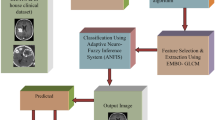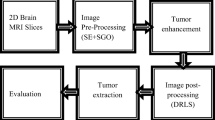Abstract
Cancer is a disease caused by an abnormal growth of cells. It is a group of 100 different diseases. This is a menacing disease which can severely affect the quality of life of someone affected by it. It can also take a toll on the emotional well-being of the patient along with physical repercussions. The cells which form malignant tumors can occur in any part of the body but the brain is an area where the chance of survival is minimal if not treated accurately in time. Radiologists and Oncologists make use of MRI scans which provide images of the brain. These images can have different appearances depending on the setting of pulse sequences of the MRI such as T1-W, T2-W, MPR, DWI, and FLAIR. This chapter focuses on the segregation of tumor region based on sequences such as T1-weighted and T2-weighted images of the brain. The segmentation is performed by making use of a fusion of BAT and Interval Type 2 Fuzzy C-Means Clustering (IT2FCM) algorithms which is aimed at simplifying the task of a radiologist. This novel approach can detect tumors of different types, different shapes, at different locations and also the segregation of tissue formations that are present in the brain.
Access this chapter
Tax calculation will be finalised at checkout
Purchases are for personal use only
Similar content being viewed by others
References
Pereira S, Pinto A, Alves V, Silva CA (2016) Brain tumor segmentation using convolutional neural networks in MRI images. IEEE Trans Med Imaging
Dey N (2020) Applications of firefly algorithm and its variants. Springer tracts in nature-inspired computing
Hussain K, Salleh MNM, Cheng S, Shi Y (2019) Metaheuristic research: a comprehensive survey
Binu D, Selvi M (2015) BFC: bat algorithm based fuzzy classifier for medical data classification. J Med Imaging Health Inform 5:599–606
Kaur T, Saini BS, Gupta S (2019) Optimization techniques for the multilevel thresholding of the medical images. In: Medical data security for bioengineers. IGI Global
Ajay Adithyan T, Sharma V, Gururaj B, Thirumalai C (2017) Nature inspired algorithm. In: 2017 international conference on trends in electronics and informatics (ICEI)
Dey N, Ashour AS, Bhattacharyya S (2019) Applied nature-inspired computing: algorithms and case studies. Springer tracts in nature-inspired computing
Fister I Jr, Yang X-S, Fister I, Brest J, Fister D (2013) A brief review of nature-inspired algorithms for optimization
Castillo O, Sanchez MA, Gonzalez CI, Martinez GE (2017) Review of recent type-2 fuzzy image processing applications, Aug 2017
Rhee FC-H, Hwang C (2003) An interval type-2 fuzzy K-nearest neighbor
Alagarsamy S, Kamatchi K, Govindaraj V, Zhang Y-D, Thiyagarajan A (2019) Multi-channeled MR brain image segmentation: a new automated approach combining BAT and clustering technique for better identification of heterogeneous tumors, May 2019
Patil P, Pawar S, Patil S, Nichal A (2017) A review paper on brain tumor segmentation and detection
Marelia M, Twalab B (2018) An adaptive Cuckoo search algorithm for optimisation
Zefan C, Xiaodong Y (2017) Cuckoo search algorithm with deep search
Alihodzic A, Tuba M (2014) Improved bat algorithm applied to multilevel image thresholding. Sci World J 2014(Article ID 176718)
Alihodzic A, Tuba M (2013) Bat algorithm (BA) for image thresholding. In: Recent researches in telecommunications, informatics, electronics and signal processing
Satapathy SC, Raja NSM, Rajinikanth V, Ashour AS, Dey N (2018) Multi-level image thresholding using Otsu and chaotic bat algorithm. Neural Comput Appl 29(12):1285–1307
Author information
Authors and Affiliations
Corresponding author
Editor information
Editors and Affiliations
Rights and permissions
Copyright information
© 2021 The Editor(s) (if applicable) and The Author(s), under exclusive license to Springer Nature Singapore Pte Ltd.
About this chapter
Cite this chapter
Kotwal, A., Bharti, R., Pandya, M., Jhaveri, H., Mangrulkar, R. (2021). Application of BAT Algorithm for Detecting Malignant Brain Tumors. In: Dey, N., Rajinikanth, V. (eds) Applications of Bat Algorithm and its Variants. Springer Tracts in Nature-Inspired Computing. Springer, Singapore. https://doi.org/10.1007/978-981-15-5097-3_7
Download citation
DOI: https://doi.org/10.1007/978-981-15-5097-3_7
Published:
Publisher Name: Springer, Singapore
Print ISBN: 978-981-15-5096-6
Online ISBN: 978-981-15-5097-3
eBook Packages: Intelligent Technologies and RoboticsIntelligent Technologies and Robotics (R0)




